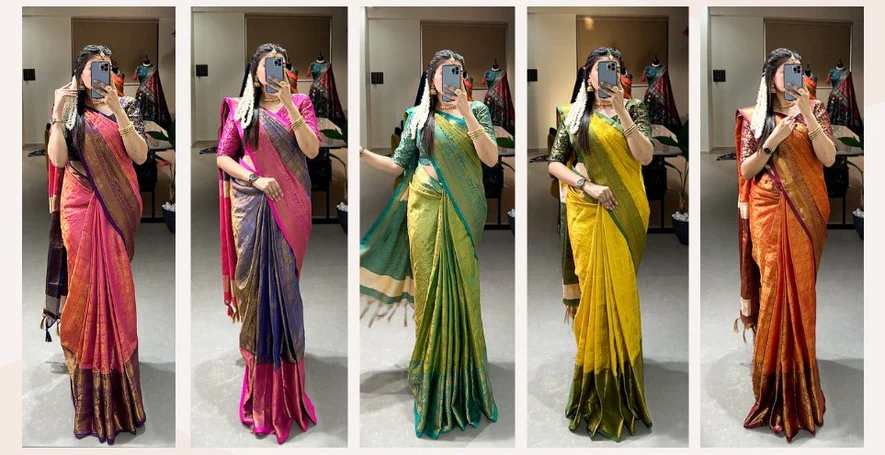[ad_1]
India, with its rich culture, is a gold mine of silk sarees, each recounting a one-of-a-kind story of custom, craftsmanship and local heritage. These smooth wonders are not simply pieces of clothing; they are a celebration of the different weaving procedures and artistry that went down through the ages. We should leave on an excursion through the heap kinds of silk sarees that enhance the energetic landscape of Indian textiles.
- Kanjeevaram Sarees:
Kanjeevaram sarees are rich in culture and easy to wear. Kanjeevaram sarees are best known for their borders, thick zari work, and a unique blend of styles. Each Kanjeevaram saree is a masterpiece, reflecting the social tradition of South India and is regularly worn during weddings and happy occasions.
- Bandhani Sarees:
Tie-dye spots of carnival! Bandhani sarees are popular during festivities and weddings, seasonal festivals of nature, etc. Bandhani sarees celebrate imagination and the energetic colours of the wild.
- Banarasi Sarees:
Hailing from the old city of Varanasi, Banarasi sarees are an image of unrivalled extravagance and dazzling craftsmanship. Woven with fine silk and improved with intricate zari work, these sarees frequently include themes roused by Mughal craftsmanship. Banarasi sarees are a timeless choice for weddings and excellent festivals, encapsulating the greatness of North Indian tradition.
- Baluchari Sarees:
Starting from the town of Baluchar in West Bengal, Baluchari sarees are known for their detailed themes and narrative motifs. These sarees normally portray scenes from stories and folklore, woven with accuracy on fine silk. Baluchari sarees are a social mixture, mixing creative narration with the charm of silk.
- Paithani Sarees:
Hailing from the territory of Maharashtra, Paithani sarees are a demonstration of Maharashtrian legacy. These sarees are portrayed by energetic peacock and blossom themes, woven with silk and zari on a handloom. Paithani sarees are many times worn during Maharashtrian cultural festivities, displaying the rich textile tradition of the locale.
- Mysore Silk Sarees:
Hailing from the social centre of Mysore in Karnataka, Mysore silk sarees are known for their fine silk, energetic varieties and mind-boggling zari borders. These sarees are portrayed by their effortlessness and class, making them appropriate for different events. Mysore silk sarees are an impression of South Indian feel and craftsmanship.
- Chanderi Sarees:
Chanderi sarees are lightweight party wear that can be worn anywhere and everywhere. They originate from Madhya Pradesh and are highly praised for their sheer surface and fine silk. Such surfaces make them breathable and easy to care for and carry. These sarees frequently highlight sensitive zari work and conventional examples.
- Tussar Sarees
Tussar silk, otherwise called “Kosa silk,” is the crude, textured silk. Tussar sarees exhibit a characteristic brilliant sheen and frequently include hand-painted or block-printed plans. The provincial appeal of Tussar sarees makes them an interesting and natural expansion to the world of Indian silk sarees.
Conclusion:
Each kind of silk saree in India twists around a specific story, reflecting the social nuances, customs, and creativity of its locale. Whether hung during celebrations, weddings, or everyday presence, these smooth marvels stand as pictures of inheritance and style.
[ad_2]












